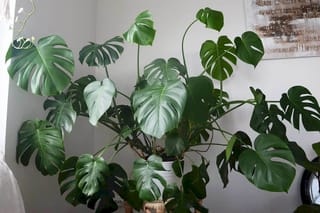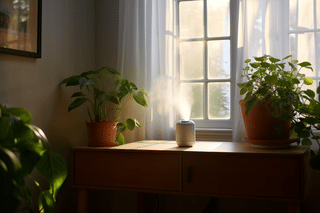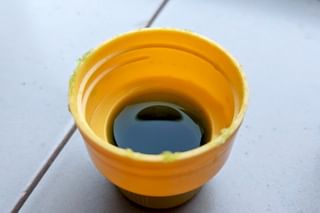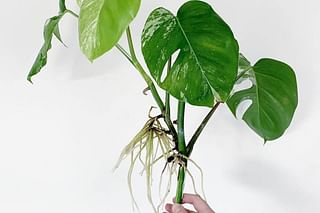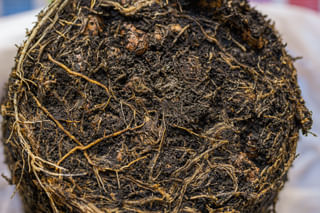How to care for a Monstera
Monsteras are very recognizable plants with big and beautiful leaves. They can be tough to take care of if you live in a colder climate, but even then, you can be successful with these plants. In this guide, we'll go over everything you need to know to help these plants thrive.
Photo of this monstera is made by roosanur on Instagram
Monsteras are very recognizable plants with big and beautiful leaves. As they're tropical plants, they can be tough to take care of if you live in a colder climate, but even then, you can be successful with these plants. They're low-maintenance plants that are great for any beginning plant owner. Even beginning plant parents can take care of a Monstera with these tips. Monsteras are also very flexible regarding light requirements, so you'll always have a good place for this plant in your house. But how do you take care of it?
In this guide, we'll go over a few different plant care topics and how you can help your Monstera thrive in your house. These topics include:
After you've finished reading this guide, you'll have all the information you need to take care of these beautiful tropical plants.
How often do I water my Monstera?
Monsteras are tropical plants, which means they like to sit in moist soil. When it comes to watering, it needs to be watered as soon as the soil at the top of the pot is dry.
You can check this by using a moisture meter or your finger. If the top 5 cm (2 inches) is dry, it's time to water your plant. It's best to not let the soil dry out too much because its leaves will start to droop. When this happens, you need to water the plant as soon as possible, because your Monstera is at risk of drying out.
Another sign that your plant is starting to dry out is when you notice brown and crispy edges on the leaves.
If you water the Monstera too much or too often, the plant will also tell you. When you overwater the Monstera, its leaves will start to "sweat". It does this to get rid of the excess moisture as quickly as possible. When you let the plant tell you what it wants, it'll be easier to help it thrive.
Because the plant tells you when something is wrong it makes this plant perfect for beginning plant owners.
Yellow, brown, or black leaf tips
When you see yellow, brown, or black tips on your Monstera leaves, it's a clear sign of overwatering. The best thing to do right now is to stop any watering, drain the excess water from the soil, and then let the soil dry out before watering again. If you notice your plant has developed root rot, it's best to repot the plant and get it in some fresh (dry) soil.
A rule of thumb to use when watering is this: Only water your plant when the top 5 cm (2 inches) is dry. If you don't check this you risk overwatering your Monstera.
How much light does a Monstera need?
The Monstera prefers bright, indirect sunlight. This is a tropical plant and thrives if you can give it the light it gets in its native environment. In nature, it's on the ground under large trees in very sunny areas, so this plant loves bright, indirect sunlight.
Make sure to avoid too much direct sunlight in the summer because this could cause burn marks on those big and beautiful leaves.
As the Monstera is near the ground in nature, it can tolerate low light but this will make it grow much slower. The plant needs light to be able to grow. If you keep the Monstera in an area that's too dark, its leaves will turn yellow. If you see this happen, it's a sign that you should move the plant to a better-lit environment.
Ideally, you should place your Monstera near east or west-facing windows where it can receive enough bright, indirect light throughout the day. If a window receives direct sunlight, move the plant a few feet away or use sheer curtains to block some of the light. Rooms with good natural light, such as living rooms, bedrooms, or offices, are perfect for Monsteras.
If there isn't enough natural light, consider using grow lights to make sure your Monstera receives the perfect amount of light.
How much humidity does a Monstera need?
Monsteras love humidity. They thrive in highly humid places because they resemble their native environments. Because of this, it's a great idea to mist your Monstera occasionally. If you have a humidifier in your house, this is also a great solution.
If you live in a very dry climate, or if your house is particularly dry, you may want to consider getting a humidifier. This will help your Monstera (and all your other plants) thrive.
If you know that it's tough for you to keep the humidity high in your house, you can follow some of the steps outlined in "10 ways to raise the humidity in your house". In that guide, we'll go over how you can help your humidity-loving plants thrive.
What is the best temperature for a Monstera?
Along with humidity and plenty of indirect sunlight, this plant also loves warmer temperatures. Normal temperatures in your house are great for most houseplants, including the Monstera. The only thing you should think about when taking care of a Monstera is that you shouldn't put it too close to a cold draft. This includes being near drafty doors and windows or AC units.
Monsteras are sensitive when it comes to cold temperatures and sudden temperature drops could shock the plant. Shocking Monsteras could kill them, so it's best to avoid this situation altogether.
The ideal temperature for a Monstera is between 21-32℃ (70-90℉). If you can provide this temperature range, your Monstera will be very happy.
What is the best soil for a Monstera?
Monsteras like moist soil, but don't like to have wet feet, meaning they don't like wet soil. To help give the Monstera the right amount of moisture to thrive in, you should use well-draining soil. You can avoid letting water sit at the bottom of the pot by choosing a pot with a draining hole at the bottom. The soil will retain all the water your Monstera needs to thrive, but any excess will be drained out of the bottom. This helps you avoid overwatering and root rot.
If you'd like to create your own soil mix, be sure to mix 1 part potting soil with 1 part coconut fibers and 1 part perlite. This mix keeps the soil light and airy, letting the excess moisture drain to the bottom of the pot, but also holding onto enough water to keep your Monstera happy.
How often should you fertilize a Monstera?
We now know that the Monstera can grow quite quickly, so you'd expect it to require a lot of fertilizer, but this is not the case. The Monstera doesn't need a lot of it, not even in the growing period.
During the spring and summer, the growing period, you should fertilize the Monstera about once per month, and during the dormancy period, in fall and winter, you shouldn't fertilize the Monstera at all. During the fall and winter, your Monstera is resting and preparing for the next growing period.
The easiest fertilizer to use for your Monstera is a liquid fertilizer, as you can add this to the water when you water your plant. The liquid fertilizer is also great when you want more control over the dosage of fertilizer in the water.
Do your plants need a little boost? Give it a slightly higher concentration! Don't do this too often, as you can overfertilize your Monstera, which will harm its roots and could kill it. I highly recommend following the packaging instructions to make sure you're always using the correct amount of fertilizer to help your plants thrive!
How do you support your Monstera's growth and encourage fenestration?
To help your Monstera grow and get those holes in the leaves (fenestration), give it the right care and a bit of fertilizer. I make sure to put mine in bright, indirect light and avoid direct sun so the leaves don't burn. I water it when the top 2-3 inches of soil feel dry and keep the air humid with a humidifier, misting, or a water tray with pebbles.
I use Leca with my Monstera, but this is definitely not a requirement. During the growing season, I feed my Monstera with a balanced, water-soluble fertilizer every month. This gives it the nutrients it needs for strong growth.
Also, support structures like moss poles or trellises help the plant grow upwards and get bigger leaves. I gently tie the stems to these supports to mimic how they climb trees in nature.
By regularly pruning dead or yellow leaves and long, spindly growth, you keep the plant focused on growing new leaves. The result? Fuller foliage and more of those fenestrations.
Pruning your Monstera for bushier growth

Pruning your Monstera is key to keeping it healthy and giving it a bushier, fuller look. By trimming certain parts of the plant, you can encourage new growth and shape it to better fit your space while ensuring it thrives.
To prune and shape your Monstera for a bushier appearance, start by picking the right time, usually in spring or early summer when the plant is actively growing. Begin by checking out the plant and spotting areas where you want more growth or a better shape.
With clean, sharp pruning shears, cut just above a node (where a leaf attaches to the stem) to promote branching. Snip away any leggy, damaged, or yellowing stems and leaves to encourage healthier growth. Focus on trimming longer stems to the desired length to help stimulate new branches and make the plant look fuller.
About rotating a Monstera
Normally, I recommend rotating your plants every few weeks to give all sides even sunlight exposure. But for Monstera, I discourage this. Monstera is a plant that grows upwards along tree trunks, so they always face away from the tree and aim towards the sun. Their large leaves are made to capture sunlight and their stems aren't flexible.
By rotating your Monstera, the plant will try to keep growing its leaves toward the light, causing a deformed plant with chaotic growth. Because of this, I recommend finding a good spot for your plant and, basically, never touching it again. This gives your Monstera this bushy, jungle look.
Tips for cleaning and dusting your Monstera's leaves
Cleaning and dusting your monstera's leaves is essential for maintaining its health and appearance. It gives you a chance to inspect your plant for pests and keeps the leaves dust-free. Dust-free leaves are important for photosynthesis.
Here are some tips to help you keep the leaves clean:
- Use a soft cloth or sponge: Dampen a soft cloth or sponge with lukewarm water and gently wipe each leaf to remove dust and dirt. Make sure the cloth is not too wet to avoid water spots or damage.
- Support the leaves: While cleaning, support the underside of each leaf with one hand to prevent tearing or bending as you wipe with the other hand. It's very easy to tear the leaf and once it has torn, it will only be easier to continue tearing, so be careful with this.
- Shower method: Sometimes it's just easier to clean your plant with a shower. You can do this by placing it in the shower or taking it outside and gently spraying the leaves with lukewarm water. Let the plant dry in a well-ventilated area before placing it back in its usual spot.
When you clean your Monstera's leaves, keep it as simple as possible. Try to avoid soap or chemicals and stick to water. If you want to give your Monstera a bit of extra protection against pests, you can spray some neem oil on the leaves after cleaning them. This also makes your plant shine a little extra!
How do you propagate a Monstera?
Photo of this Monstera cutting is made by goodgrowing on Instagram
Propagating a Monstera is easier than most plants and there are several ways of doing this. The first way is to prune your Monstera and cut off a larger part of the stem. This way you give your Monstera enough moisture and nutrients to start growing roots on its own. Another way is to wait until the Monstera starts to grow air roots. Your Monstera is now telling you it's ready to be propagated. You can now cut off the stem below the air roots.
You should have a cutting quite similar to the picture above, of course without the fully developed roots. By putting this cutting into water, you help the Monstera stem grow new roots and become an independent plant. When the roots look like the ones in the picture, it's ready to be planted in soil. And with that, you have a new plant, for free!
When and how do you repot a Monstera?

Monsteras grow relatively fast. This means that it's always a good idea to get a pot that's a little bigger than its roots currently are. This gives the plant plenty of space to grow. If your Monstera does well and grows consistently, you have to repot it about every 2-3 years. That's when it starts to outgrow its current pot and it'll need more space to grow. If you think that it has grown enough and you don't want it to grow any larger, you can also choose to stop repotting it and prune it back to the size that you prefer. This helps to keep the growth in check.
As you might notice, when the Monstera is growing over a few months, it grows horizontally by nature. This is where that moss pole comes in that you might have seen before. This moss pole trains the Monstera to grow vertically instead of horizontally.
If you prefer the plant to grow taller instead of wider, this is what you could use as well. This is completely up to your preferences and is not required in any way. A moss pole can be a real space saver as well, so you can keep several different plants in a corner, rather than one wide plant.
Troubleshooting Monstera plants
If your Monstera plant is looking a bit leggy or droopy, it might be hinting that something in its care needs tweaking. Here are some troubleshooting tips:
Leggy Growth
If your Monstera is looking a bit leggy, it might need more light. Try moving it to a brighter spot with plenty of indirect sunlight-east or west-facing windows are usually great. Make sure your Monstera has room to breathe. If it's cramped among other plants or too close to walls, it might not be getting the light and airflow it needs. Give it some space to thrive!
Droopy Leaves
Drooping Monstera leaves got you worried? There are a few common things that might be causing the issue. First off, incorrect watering is a big one! It can come from either overwatering or underwatering. Stick your finger about 2-3 inches deep into the soil to check the moisture. If it's dry, give your plant a thorough watering. If it's soggy, let the soil dry out a bit more between waterings, and make sure the pot has good drainage.
Another thing to consider is the humidity. Monsteras love high humidity, so if the air is too dry, the leaves can start to droop. You can bump up the humidity by misting the plant regularly, using a humidifier, or placing it on a pebble tray filled with water. Also, watch out for temperature stress, as these plants do best in a consistent indoor temperature between 70-90℉, away from drafts or direct heat sources.
Lastly, think about nutrient deficiency and whether your Monstera might be root-bound. Not getting essential nutrients can weaken the plant, leading to droopy leaves, so feed it with a balanced, water-soluble fertilizer during the growing season. If the roots are circling the bottom of the pot, it might be time to repot into a larger container.
Dropping leaves
The leaves on my Monstera are dropping, what's wrong? Often there is nothing wrong with your plant. A Monstera will drop its old leaves when they're putting out new leaves. The plant is dropping the older leaves to be able to provide the new stems and leaves with nutrients to grow big and strong. So this is completely natural and not a reason to worry about the health of your plant.
Which common pests does a Monstera suffer from?

Monstera is a pretty tough plant and usually doesn't get many pests when it's healthy. But if it's stressed, shocked, or weakened, it might attract pests like scale insects, mealybugs, and spider mites. You can prevent these by paying attention to what your plant needs.
Common pests include spider mites, which spin fine webs and cause tiny yellow or brown spots on the leaves. Mealybugs show up as white, cottony clumps often found in leaf axils, leading to stunted growth and leaf drop. Scale insects look like small, brown bumps on stems and leaves, causing yellowing and weaker plant health. Aphids, are small, soft-bodied bugs that gather on new growth, resulting in distorted and curled leaves.
Different pests affect your monstera in various ways. Spider mites suck the sap, causing speckled leaves and a drop in plant vigor. Mealybugs also feed on sap and leave behind honeydew, which can lead to sooty mold. Scale insects weaken the plant by draining sap, making leaves yellow, and dropping early. Aphids drain nutrients from new shoots, which can deform the plant and reduce its overall vitality.
How do I treat and prevent pests?
If you do notice some pests are showing up, like mealybugs, it's not too late. The first step you should take is to make sure that your plant is getting the proper light and water it needs. The goal is to make sure the Monstera can recover from these pests. The second step is to carefully clean the leaves and stems with soapy water. This will drown the pests and allow you to get rid of the pests on the whole plant at once.
The most important thing when dealing with pests is to keep giving your plant a fighting chance by caring for them in the way they prefer: proper light, consistent watering schedule, and a high humidity environment. When the pests are gone this will help the plant to recover more quickly and thrive again.
What common diseases affect a Monstera and how do I treat them?
Monstera plants can be prone to a few common diseases, each impacting the plant differently. Here are some of the usual problems and how to deal with them:
Root rot
This is often caused by overwatering or poor drainage, leading to dark, mushy roots and yellowing leaves. To treat root rot, remove the plant from its pot, trim away any affected roots, and repot it in fresh, well-draining soil. Make sure the new pot has drainage holes and adjust your watering schedule to prevent it from happening again.
Leaf spot diseases
Fungal or bacterial infections can cause leaf spots, which appear as brown or black lesions on the leaves. To treat leaf spot diseases, remove the affected leaves and improve air circulation around the plant. Avoid overhead watering to keep the foliage dry, and consider using a fungicide if the problem persists.
Powdery mildew
This fungal disease looks like a white, powdery coating on the leaves. To treat powdery mildew, increase air circulation, and reduce humidity around the plant. Wipe the affected leaves with a mixture of water and mild detergent, and apply a fungicide if necessary.
Anthracnose
This is another fungal disease that leads to dark, sunken spots on the leaves and stems. To treat anthracnose, trim and get rid of the affected parts, clean your pruning tools, and use a copper-based fungicide to stop it from spreading further.
Bacterial blight
Bacterial blight shows up as water-soaked spots that turn brown and rot, spreading fast in moist conditions. To tackle it, remove and dispose of infected leaves, improve humidity control, and avoid overhead watering. Copper-based bactericides can also help manage the disease.
Is a Monstera toxic to cats and dogs?
Tropical plants are often toxic and the Monstera is no exception, unfortunately. The sap of the stems and leaves could cause indigestion and vomiting in both humans and pets. So try to keep the Monstera away from small children and pets if you know they'll try to eat the stems and leaves.
Conclusion
As you can see, a Monstera is a beginner-friendly plant. It does take some getting used to if you're coming from succulents or cacti. By following the tips in this guide, you will be able to help this plant thrive.
By taking care of Monsteras properly, you'll be able to enjoy this plant for many years and grow it as large as you want to. If you have small children or pets, you might need to take some precautions to protect them and your plant, because it is toxic.
Overall, this plant is beginner-friendly, because it will tell you what it wants and needs. If it's too dry, it'll get brown and crispy edges on its leaves and if it gets too much water, the leaves will turn yellow. By recognizing the signs the plant shows you, you'll be able to take care of it without too many problems. Even if you're new to taking care of houseplants.
Thank you for reading this post! I hope it helps you to keep your plants healthy and beautiful! If you're looking for more guides on specific plants, you can always request a plant guide to get a guide for the plant you have trouble with.
Test your plant care knowledge
Quiz completed!
Want to learn more? Sign up for my newsletter to receive free tips in your inbox!
Sign up now!